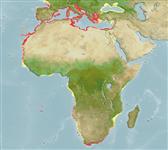>
Eupercaria/misc (Various families in series Eupercaria) >
Sparidae (Porgies)
Etymology: Diplodus: Greek, diploos = twice + Greek, odous = teeth (Ref. 45335).
More on author: Linnaeus.
Issue
This subspecies is reported to have no genetic difference between the subspecies Diplodus sargus cadenati. See V.S. Domingues et al. 2007. Journal of Experimental Marine Biology and Ecology 346 (2007):102-113 (F. M. Porteiro, pers.comm. 02/08). Presence in Canary Is. to be reviewed since D. bellottii and D. cadenati are recognized as valid species, not any more as subspecies of D. sargus.
Environment: milieu / climate zone / depth range / distribution range
Sinh thái học
Biển; Thuộc về nước lợ gần đáy; Ở đại duơng, biển (Ref. 51243); Mức độ sâu 0 - 50 m (Ref. 12460), usually 0 - 50 m (Ref. 13780). Subtropical; 48°N - 36°S, 29°W - 42°E
Northeastern Atlantic from Brittany (France) to Gibraltar, and Madeira I.; Mediterranean Sea and southwestern Black Sea.
Length at first maturity / Bộ gần gũi / Khối lượng (Trọng lượng) / Age
Maturity: Lm ?, range 25 - ? cm
Max length : 45.0 cm TL con đực/không giới tính; (Ref. 3397); common length : 22.0 cm TL con đực/không giới tính; (Ref. 3397); Khối lượng cực đại được công bố: 1.9 kg (Ref. 40637); Tuổi cực đại được báo cáo: 10 các năm (Ref. 26328)
Các tia vây lưng cứng (tổng cộng) : 11 - 12; Các vây lưng mềm (tổng cộng) : 12 - 15; Tia cứng vây hậu môn: 3; Tia mềm vây hậu môn: 11 - 14. Body with 5 black and 4 grey vertical bands. Snout is longer than the eye diameter (Ref. 35388).
Inhabits coastal rocky reef areas (Ref. 12460) and Posidonia oceanica beds. Like other sparids, it is very active and frequents the surf zone, primarily at dawn (Ref. 13780). Feeds on shellfish and other benthic invertebrates which it picks from the sediment (Ref. 5377).
Sexes separate or protandrous (Ref. 4781). In some areas, this species occurs as a digynic hermaphrodite, that is, males and females developing from intermediate juveniles (Ref. 52202). However, protandry with possible digyny was later confirmed (Ref. 103751). Reaches sexual maturity at 2 years, with an approximate size of 17 cm. Spawning happens from January to March. Egg size 0.8-0.9 mm; larval length at hatching 2.6 mm. Also Ref. 28504.
Bauchot, M.-L., 1987. Poissons osseux. p. 891-1421. In W. Fischer, M.L. Bauchot and M. Schneider (eds.) Fiches FAO d'identification pour les besoins de la pêche. (rev. 1). Méditerranée et mer Noire. Zone de pêche 37. Vol. II. Commission des Communautés Européennes and FAO, Rome. (Ref. 3397)
IUCN Red List Status (Ref. 130435)
Threat to humans
Harmless
Human uses
Các nghề cá: buôn bán nhỏ; Nuôi trồng thủy sản: Tính thương mại; cá để chơi: đúng
Các công cụ
Special reports
Download XML
Các nguồn internet
Estimates based on models
Preferred temperature (Ref.
123201): 15 - 24.1, mean 18.8 °C (based on 400 cells).
Phylogenetic diversity index (Ref.
82804): PD
50 = 0.5000 [Uniqueness, from 0.5 = low to 2.0 = high].
Bayesian length-weight: a=0.01175 (0.01050 - 0.01315), b=3.04 (3.01 - 3.07), in cm total length, based on LWR estimates for this species (Ref.
93245).
Mức dinh dưỡng (Ref.
69278): 3.4 ±0.1 se; based on diet studies.
Thích nghi nhanh (Ref.
120179): Trung bình, thời gian nhân đôi của chủng quần tối thiểu là 1.4 - 4.4 năm (K=0.11-0.25; tmax=10; tm=2).
Prior r = 0.54, 95% CL = 0.35 - 0.80, Based on 5 data-limited stock assessments.
Fishing Vulnerability (Ref.
59153): High vulnerability (57 of 100).
Climate Vulnerability (Ref.
125649): Low to moderate vulnerability (26 of 100).
Nutrients (Ref.
124155): Calcium = 74.5 [38.6, 152.0] mg/100g; Iron = 0.993 [0.559, 1.844] mg/100g; Protein = 19.7 [18.8, 20.6] %; Omega3 = 0.35 [0.20, 0.60] g/100g; Selenium = 20.9 [9.8, 39.7] μg/100g; VitaminA = 15 [5, 42] μg/100g; Zinc = 1.01 [0.69, 1.43] mg/100g (wet weight); based on
nutrient studies.
